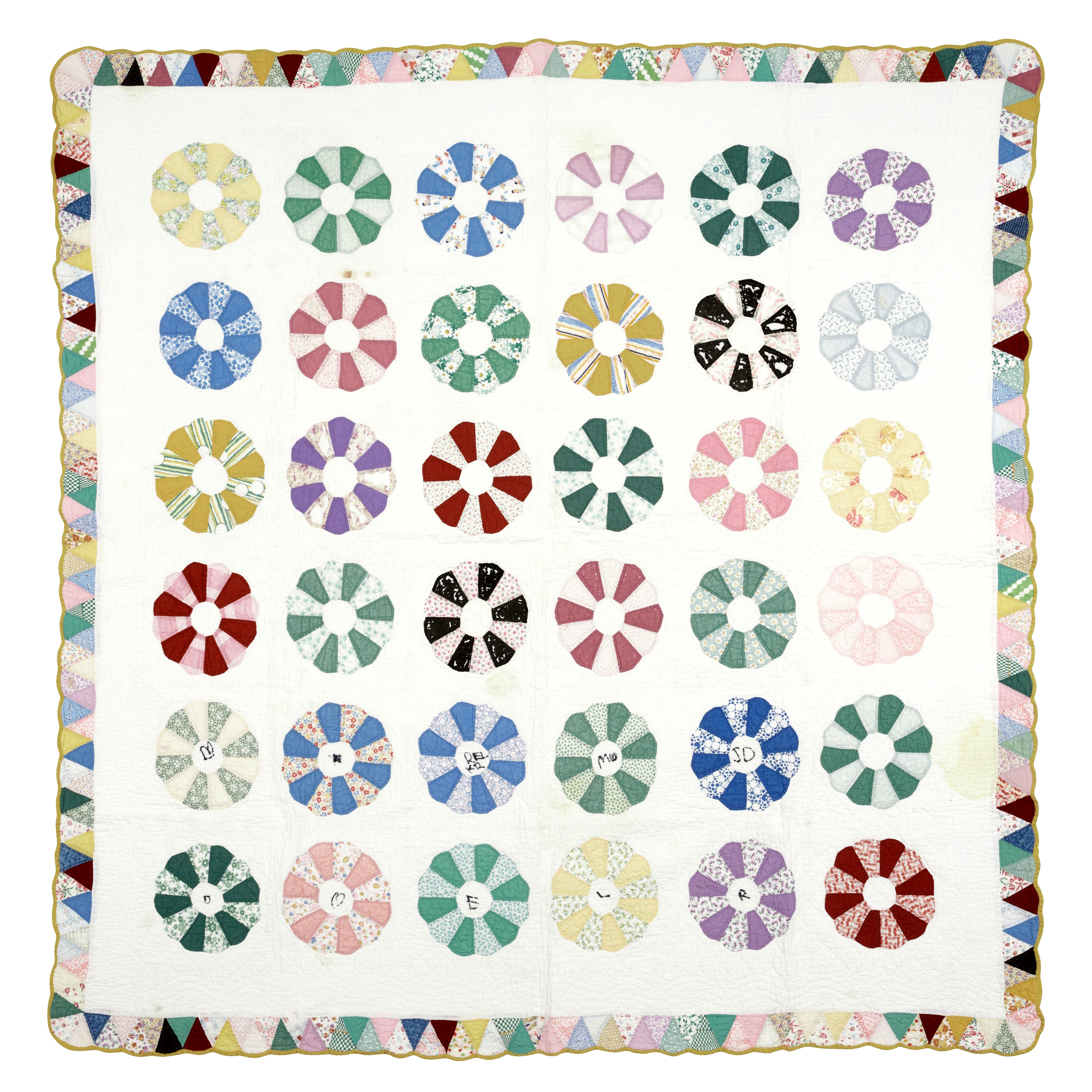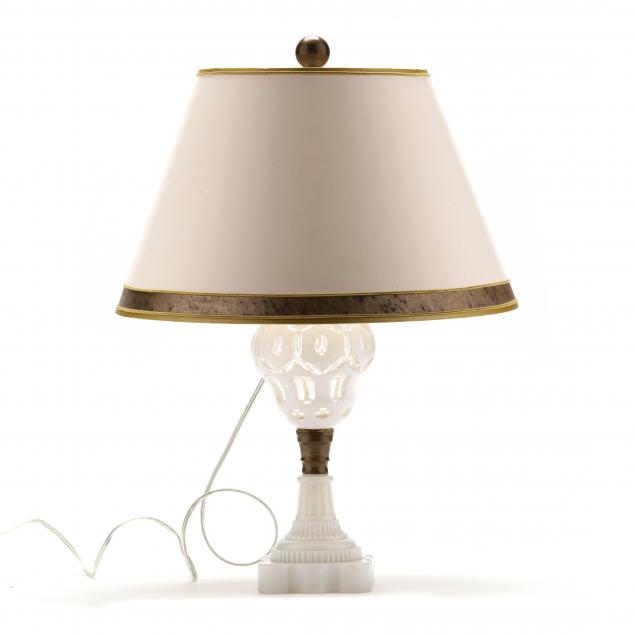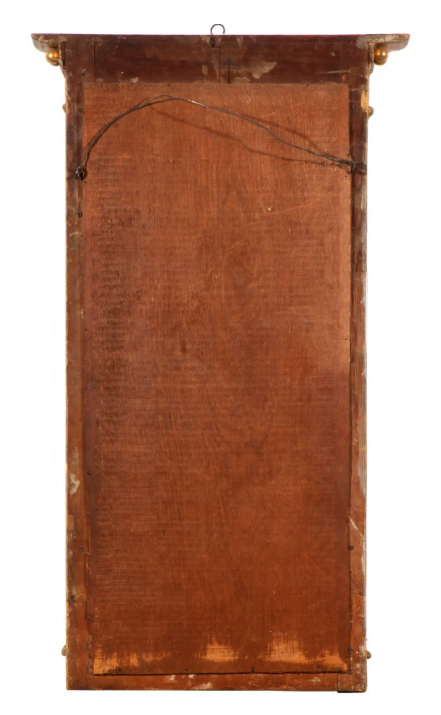


Theorem of Fruit in a Porcelain Bowl
AMERICAN SCHOOL
Circa 1860
Ink and watercolor on velvet
18 × 15 IN (Sight)
$2,500
PROVENANCE
Martin and Estelle Shack Collection
︎Purchase
︎︎︎Object Sheet
AMERICAN SCHOOL
Circa 1860
Ink and watercolor on velvet
18 × 15 IN (Sight)
$2,500
PROVENANCE
Martin and Estelle Shack Collection
︎Purchase
︎︎︎Object Sheet
Theorem paintings grew in popularity at the turn of the 19th century in England. Soon thereafter, the art form migrated to America where it became well-known in the 1820s and 1830s. Notably, most theorem painters were women and the practice was largely considered a lady’s pastime. Theorem paintings are stenciled, watercolor artworks depicting still-life arrangements, floral compositions, symbols, mourning scenes, or genre paintings. They were commonly composed on cotton, velvet, or paper, and artists worked in watercolor and usually with the guidance of a manual.
We acquired this theorem from the Martin and Estelle Shack Collection of American Folk Art. This work appealed to us because of its unique colorways reminiscent of soothing pastels and bright gemstones. Additionally, the carefully considered gradating visible in each stylized piece of fruit and foliage brings depth and volume to the subject matter. The composition stands as a perfect example of a beautifully executed theorem painting.
We acquired this theorem from the Martin and Estelle Shack Collection of American Folk Art. This work appealed to us because of its unique colorways reminiscent of soothing pastels and bright gemstones. Additionally, the carefully considered gradating visible in each stylized piece of fruit and foliage brings depth and volume to the subject matter. The composition stands as a perfect example of a beautifully executed theorem painting.




Pair of Spaniels
BRITISH, STAFFORDSHIRE
Circa 1830–1850
SOLD
PROVENANCE
Ruth J. Hope Collection
︎Purchase
︎︎︎Object Sheet
BRITISH, STAFFORDSHIRE
Circa 1830–1850
SOLD
PROVENANCE
Ruth J. Hope Collection
︎Purchase
︎︎︎Object Sheet
Staffordshire County in the West Midlands of England has long been known as the epicenter of ceramic production in the UK since the 17th century. This region lends its name to these quintessentially English animal figurines– the most well-known of their kind being the Staffordshire dogs. Typically modeled after Spaniels, Staffordshire dogs rose in popularity during the Victorian Era and quickly became a fixture of countryside interiors throughout England. We find these two distinct pairs of Spaniels incredibly charming and have enjoyed them on our mantels for a number of years. They bring warmth, fun, and a touch of whimsy to any living space. Please note that these pairs are being sold separately.



Mourning Picture, New England School
MASSACHUSETTS
Circa 1820
Watercolor on paper
9 × 7 IN (Sight)
$6,500
PROVENANCE
The Siegmund Collection
︎Purchase
︎︎︎Object Sheet
MASSACHUSETTS
Circa 1820
Watercolor on paper
9 × 7 IN (Sight)
$6,500
PROVENANCE
The Siegmund Collection
︎Purchase
︎︎︎Object Sheet
Mourning pictures rose in prominence in America during the late 18th century. These compositions were typically created by pupils in women’s academies who gifted them to acquaintances in mourning or painted them in honor of a lost loved one. This composition was created in remembrance of Mrs. Desire Cushing, wife of Timothy Cushing, who died at the age of 79. Our research at the University of Massachusetts Amherst Library yielded interesting insight into Mrs. Desire Cushing’s life. She raised a family of 11 children and lived much of her life in Cohasset, MA. Timothy Cushing, her husband, made a living as a carpenter and farmer, and one can imagine Mrs. Cushings’ days were filled with homesteading tasks and all the complexities that come with raising children. We were drawn to this particular piece because of its intriguing subject matter and balanced composition. The large, graphic willow tree and stately home are expertly juxtaposed with the soft rolling hills and windswept grasses that animates the foreground. Together, these elements work in concert to create a whimsical mourning picture.






American Folk Pictorial Hooked Rug
NEW ENGLAND
Circa 20th century
Price Available Upon Request
PROVENANCE
Laura Fisher Collection
︎Purchase
︎︎︎Object Sheet
NEW ENGLAND
Circa 20th century
Price Available Upon Request
PROVENANCE
Laura Fisher Collection
︎Purchase
︎︎︎Object Sheet
The joyful composition depicted on this hooked rug epitomizes the jubilant spirit of American Folk Art. Further, the process by which these rugs were created speaks to the origins of Folk Art as practical craftwork. Specifically, hooked rugs were made by hooking many small pieces of woolen fabric through a piece of backing made of burlap or cotton, creating neat and uniform loops of fabric. These small pieces of fabric were often scraps from other textile works that were too small or damaged to use for other purposes. This artistic practice exemplifies the resourcefulness, conscientiousness, and “waste not, want not” ethos of craftwork in America during this time. We acquired this piece because of its painterly aesthetic. The balance between the bold composition and soft color story of creamy pinks, jewel-toned greens, crimson reds, and pops of blue makes this rug particularly compelling. We feel this rug could be wall mounted as a focal point of a den/snuggery just as easily as it could be laid at the foot of a well-dressed bed. In truth, it would add a beautiful decorative flourish to any intimate interior space.


Two Miniature Portraits of Ladies
ATTRIBUTED TO J. EVANS
Circa 1840
Watercolor, pen, and ink on paper
4 × 3 IN (Sight)
$3,500 (Pair)
PROVENANCE
Edgar William and Bernice Chrysler Garbisch
︎Purchase
︎︎︎Object Sheet
ATTRIBUTED TO J. EVANS
Circa 1840
Watercolor, pen, and ink on paper
4 × 3 IN (Sight)
$3,500 (Pair)
PROVENANCE
Edgar William and Bernice Chrysler Garbisch
︎Purchase
︎︎︎Object Sheet
These miniature watercolor portraits skillfully capture the fashion finery of the late 19th century. Attributed to the elusive watercolor portrait painter J. Evans, these silhouettes depict two Massachusetts women in typical attire of the time. These miniature portraits are rendered in a highly stylized manner, which draws one into the compositions. Further, the artist adeptly illustrates the textures of the various textiles used for women’s clothing during the late 19th century in America. Further, the ribbons, lace, embroidery, pleating, and puffed sleeves that the artist so skillfully depicts make these ostensibly simple garments extremely interesting to the eye. We acquired these portraits for the wonderful, jewel-like quality of their scale, the fantastic detailing of the costuming, and their undeniable charm.


American Dresden Plate Pattern Quilt
Martha’s Vineyard, MASSACHUSETTS
Circa 1940–1950
Cotton
65 × 73.5 IN (Sight) (Unmounted)
$1,800
PROVENANCE
Vineyard Dreams, Sotheby’s New York
︎Purchase
︎︎︎Object Sheet
Martha’s Vineyard, MASSACHUSETTS
Circa 1940–1950
Cotton
65 × 73.5 IN (Sight) (Unmounted)
$1,800
PROVENANCE
Vineyard Dreams, Sotheby’s New York
︎Purchase
︎︎︎Object Sheet
Dresden Plate quilts became popular in the 1920s and 30s in America. Modeled off of the beautiful, ornately designed ceramic tableware that Dresden, Germany has become so well known for, these quilts are often designed to mimic the brightly colored flowers that characterize many Dresden ceramic motifs. Typically, Dresden plate quilts are made from wedges of fabric that are pieced together to create designs of petals, emanating from an appliqué button or circular piece of fabric placed over the center joins. The plate is then sewn into a block, and the block is subsequently sewn into the larger quilt. We acquired this quilt for love of its hand-made imperfections and lively character. The design also marries two of our great loves among antiques, ceramics, and quilts!



American Cut-To-Clear Whale Oil Table Lamp, Wired
Hillsborough, NORTH CAROLINA
Late 19th century
Glass with brass fittings, now electrified
4 × 4 × 20 IN
$750
PROVENANCE
American Folk Art interior from North Carolina
︎Purchase
︎︎︎Object Sheet
Hillsborough, NORTH CAROLINA
Late 19th century
Glass with brass fittings, now electrified
4 × 4 × 20 IN
$750
PROVENANCE
American Folk Art interior from North Carolina
︎Purchase
︎︎︎Object Sheet


American Double Wedding Ring Quilt Columbus, OHIO
Circa 1930–1940
Cotton
65 × 73.5 IN (Sight) (Unmounted)
SOLD
PROVENANCE
Private Ohio Quilt Collection
︎Purchase
︎︎︎Object Sheet
Circa 1930–1940
Cotton
65 × 73.5 IN (Sight) (Unmounted)
SOLD
PROVENANCE
Private Ohio Quilt Collection
︎Purchase
︎︎︎Object Sheet
Wedding quilts exemplify the wonderful sense of tradition, history and craftsmanship that make textile arts such an important part of the historical record. Popular during the 19th and 20th centuries in America, commemorative quilts were an important piece of wedding practice and ritual. The patterns that appear on wedding quilts can vary, however they tend to feature interlocking rings that symbolize the intertwining of two souls in marriage. This beautiful, museum-quality wedding quilt features a double ring pattern in jubilant hues of pale yellow, pink, and light blues. This beautiful quilt can be wall mounted as a central focal point in a living space or used everyday to finish a bed spread. As collectors, we were drawn to this quilt’s enticing color story, exceptional condition and traditionally beautiful motif.



Federal Giltwood & Églomisé Painted Mirror
NEW ENGLAND
Late 19th century
Giltwood and mirrored glass
18 × 1.5 × 40 IN
$2,700
PROVENANCE
Americana Collection in California
︎Purchase
︎︎︎Object Sheet
NEW ENGLAND
Late 19th century
Giltwood and mirrored glass
18 × 1.5 × 40 IN
$2,700
PROVENANCE
Americana Collection in California
︎Purchase
︎︎︎Object Sheet

American Hooked Rug Runner
Pittsburgh, PENNSYLVANIA
Circa 1920–1930
Wool yarn on burlap base
3 × 17 IN (Unmounted)
$400
PROVENANCE
Ada and Robert Brandegee Collection
︎Purchase
︎︎︎Object Sheet
Pittsburgh, PENNSYLVANIA
Circa 1920–1930
Wool yarn on burlap base
3 × 17 IN (Unmounted)
$400
PROVENANCE
Ada and Robert Brandegee Collection
︎Purchase
︎︎︎Object Sheet